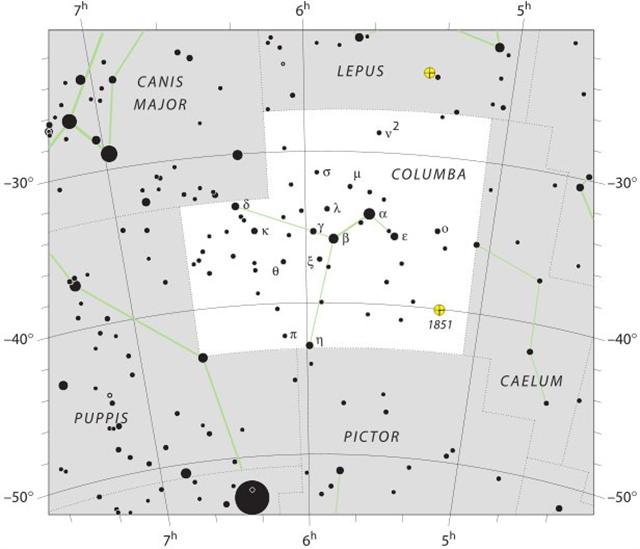Once again, when Sun enters the 'house' of Orion he first spends 5 days at Heka, before arriving to Betelgeuze, which is followed by the RA line through Praja-pāti, Menkalinan, and Mahashim. With green I have below marked all my 5 so far listed Greek lettered stars of Columba, in order to allude to the Dove of Noah. And then we can imagine the hanau glyphs are illustrating the birth of new Land (= 'fire') after the Deluge (winter), like when high tide is receding to reveal the reef.
There are several more Greek lettered stars in Columba, but only 5 of them are needed for the outline of the figure. In my astronomy book I can find an additional 7, but in the map from Wikipedia there are 15 in all. In a moment I will update my star list, but first we should notice RA 18h with θ Arae (273.8) in the night sky of June 19. The upside down fire altar should be a contrast to the great hot 'fire' taking command in the sky of northern midsummer. And in the night of June 19 the observer would have remembered day 354 (December 20, the day before the solstice). As to my redmarked day number 535 (= 170 + 365) I happened to notice the equation 5 * 107 = 535. θ is the last star in the Ara constellation, and the ancient meaning of this letter was described as a wheel by the Phoenicians but for the Egyptian it meant 'good':
When the wheel of time has come full cycle around and the upside down fire-altar is in the past the times ahead should be good (or lucky Sa'ad). Wezn for β Columbae means 'weight' and a plumb-line has a weighty symbol of Saturn at its bottom end. The day number for June 17 is 168, a quite well-known but so far ambigous number for us. We can see that this date is where Sun leaves Heka and enters his habitation of Ardra. In the night of June 17 they would have recognized Etamin (γ Draconis), a most important star in far antiquity. But for the moment we have to postpone that discussion. Instead, I wish to recall the Mayan use of 168: ... In Kelley's Deciphering the Maya Script he has pointed out that there are distance numbers of 168 days between each of the pictures in a zodiac in the Paris Codex. These intervals served to put the consecutive constellations on opposite sides of the sky roof rather than next to each other:
|









